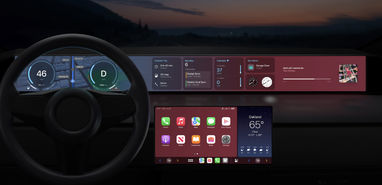
When Apple Inc. embarked on revamping CarPlay software a few years ago, it initially saw it as a means to counter Android’s encroachment into vehicles. However, with Apple’s abandonment of its own car project, CarPlay has now emerged as the company’s last hope to make significant inroads into the automotive market.
The concept behind the new CarPlay, internally referred to as Project IronHeart within Apple, aimed to elevate the system by seamlessly integrating it into vehicles. It would extend its control beyond just additional screens to encompass a vehicle’s instrument cluster, radio, and even features like the air conditioning system. This marks a significant departure from the current CarPlay interface, which primarily focuses on accessing Apple services and lacks control over most of a vehicle’s functions.
Apple’s decision to overhaul CarPlay was primarily driven by concerns over Android’s advancements in the automotive sector. With Google’s Android Auto gaining traction, offering users a smartphone-like interface for music, podcasts, voice control, and navigation, Apple felt the need to up its game.
However, Google took a leap forward by introducing Android Automotive, which is integrated directly into the vehicle itself. This integrated approach has gained momentum in the automotive industry, with various manufacturers offering vehicles equipped with the Android operating system. As a result, Android Automotive has quickly become the market leader, capturing an estimated 35% of the vehicle operating system market within just seven years.
In response to this challenge, Apple has revamped CarPlay in a bid to win over both consumers and automakers with its sleeker interface and enhanced customization. Yet, unlike Android Automotive, the new CarPlay still relies on the iPhone as its underlying platform, rather than being a standalone operating system embedded in the vehicle.
Although Apple explored the possibility of turning the new CarPlay into a full-fledged operating system for vehicles, practical considerations such as the need for Apple-designed chips and proprietary technologies made this approach unfeasible for widespread adoption.

As of now, the rollout of the new CarPlay has been limited, with only Porsche and Aston Martin officially announcing support. This limited adoption, coupled with the absence of a monetization strategy, poses a challenge for Apple in its quest to gain a foothold in the automotive industry.
To address this challenge, Apple could consider several options:
- Introduce a licensing fee: Apple could charge automakers for CarPlay support, leveraging the demand from enthusiasts who prioritize this feature when purchasing a vehicle.
- Offer a premium version: Apple could maintain the current CarPlay as a free feature while introducing a premium version, CarPlay+, with additional functionalities for a fee, similar to its approach with other services like Apple TV+.
- Enhance customization: Instead of creating custom versions for each automaker, Apple could provide a range of templates within the operating system, allowing users to personalize the CarPlay experience themselves.
Time is of the essence for Apple to expand CarPlay’s adoption among automakers, lest it loses ground to Android. Moreover, developing a monetization strategy for CarPlay is crucial for Apple to establish a lucrative presence in the automotive market.
With the cancellation of Apple’s car project, CarPlay has transitioned from being a stepping stone towards an Apple vehicle to becoming the company’s primary initiative in the automotive realm. As such, its success is paramount for Apple’s future in the industry.
Apple Suppliers Gear Up for Major AirPods Launch
As Apple gears up for the largest AirPods launch to date, its overseas suppliers are ramping up production for the upcoming AirPods line. With plans to manufacture 20-25 million units, an increase over previous models, production is set to commence in May, paving the way for a release around September or October. This heightened production signifies Apple’s renewed focus on the lower end of the market.
The new AirPods models, codenamed B768(E) and B768(M) for entry-level and mid-level respectively, will feature a redesigned form factor, improved fit, and USB-C charging cases. Additionally, the mid-level variant will boast active noise cancellation and Find My integration for easier tracking.

Apple is also working on significant software updates for AirPods as part of the iOS 18 rollout, including a mobile hearing aid mode for AirPods Pro and a hearing test feature. Furthermore, rumors suggest that the new Apple Watch set to launch this fall may incorporate a pulse oximeter, although it may not be compatible with existing models.
Looking ahead, another iteration of AirPods Pro is expected next year. Additionally, Apple is reportedly developing future AirPods models with low-resolution cameras for environmental scanning, indicating the company’s long-term vision for the product line.
US Department of Justice Prepares to Sue Apple
In a continuation of regulatory challenges, the US Department of Justice is gearing up to file an antitrust lawsuit against Apple, alleging anti-competitive behavior that stifles smaller competitors. While Apple may argue against the merit of the case and could potentially prevail in court, the lawsuit could tarnish its reputation as a company committed to fair practices. However, the impact on iPhone sales is expected to be minimal.








By Andrej Kovacevic
Updated on 14th July 2024